Showdown: BMW R 1250 GS Vs Harley-Davidson Pan America 1250 Special

The OG Adventure Tourer takes on the young upstart
C’mon, you knew it was going to happen. How could we not put the newcomer to the ADV scene head-to-head with the long standing heavyweight from the Fatherland? Our comparison of the Harley-Davidson Pan America 1250 Special and BMW R 1250 GS kicks off a series of monthly two-bike tests for 2022. Look out for a new scorchin’ comparison from MO every month. Spanning the smorgasbord of genres, your favorite kooky MO characters will ride, review, and bicker about some of the spiciest meatballs on the market today. To kick things off though, America versus Germany!
With COVID still rearing its ugly peplomers, travel to far-off lands remains on hold for most of us. But that doesn’t mean your raging wanderlust must be shamefully tucked into your proverbial waistband. No. Let your passion loose! There are, no doubt, exciting opportunities to be had locally, too!
BMW R 1250 GS vs Harley-Davidson Pan America 1250 Special
attributes shining through the dust. The BMW R 1250 GS excelled with a level of fit, finish, and refinement that can only come from decades of experience while the Pan America came out punching from Harley-Davidson showing that you can’t write the Motor Co. off, even when delivering something entirely out of their wheelhouse.
BMW R 1250 GS
+ Highs
- An unmatched level of refinement
- Quick confident handling on-road
- Stonkin’ mid-range power
– Sighs
- Vague front end feel at the handlebar
- Not as much electronic adjustment as the H-D
- Suspension can feel unbalanced off-road as speeds increase
Harley-Davidson Pan America 1250 Special
+ Highs
- Rowdy new engine
- Confidence inspiring off-road
- Touring comfort on par with the class
– Sighs
- The handlebar position is somewhat off
- Slow steering
- First year bobbles do exist
During the planning stage for our test, a quick search of options for adventure riding Stateside in January confirmed our heading. Toward the shadows of the Valley of Death we would go. Death Valley is a spectacular place to explore in the winter as it’s one of the few times of year the mercury isn’t bubbling up near 120º F. It also helps that your MO crew of miscreants happen to be about four hours from said valley. With 3,000 square-miles of terra stretching from nearly 300-feet below sea-level to more than 11,000-feet skyward, we were sure to find terrain to test the limits of our machine’s capabilities, if not, our own.
Pitting the Pan America and R 1250 GS head-to-head made the most sense to us. Using the longest running, most established modern adventure touring motorcycle as the standard, we wanted to see how the new Harley-Davidson truly stacked up. There’s no doubt in our mind that H-D delivered a home run straight out of the gate with the Pan America, but measuring it side-by-side and back-to-back with the BMW would truly show whether or not the $20,000 American-made ADV has truly earned its stripes.
2019 BMW R1250 GS/ R1250 GS Adventure First Ride Review
2021 Harley-Davidson Pan America 1250 Special Review – First Ride
Our test began as many trips do, getting up early and getting the hell outta Dodge. Once we had about 200 miles of slab done and dusted, our time on the interstate was behind us, and the immediate need for spit-roasted lamb meat breakfast burritos was imminent. Greek breakfast burritos for my men, 91 for our horses.
At this point, had either machine returned an unfavorable review from a few hours of freeway cruising, we might as well have stopped the test right there. It is, arguably, the most essential aspect these bikes should excel at. As expected, neither machine disappointed.
On the BMW, switching the ride mode to Road offers a more cush experience as the suspension settings are preset to the GS’s ride modes. Having the ability to alter the bike’s character between sport, off-road, and touring on both bikes broadens their usefulness in a variety of ways – another reason adventure motorcycles can be considered the Swiss army knife of two wheels.
As tested, our BMW was equipped with seven ride modes. The first four: Dynamic, Dynamic Pro, Enduro, and Enduro Pro are optional, while Road, Rain, and Eco come standard. Ride modes ending in “Pro” allow additional adjustment of throttle response, traction control, and ABS.
The Pan America Special also comes equipped with seven ride modes. From H-D we have Rain, Road, Sport, Off-road/Plus, and Custom A for base models with Custom Off-road/Plus and Custom B reserved for Special models. Harley’s customizable modes let the rider alter engine map, engine braking, throttle response, traction control, ABS, suspension damping, and adaptive ride height settings, giving it a fair amount more customization than the BMW in this regard.
If you’ve been around for a while, you might remember our guest tester John Nave. John first joined our merry band of misfits in 2018 for our Big-Bore Adventure Touring Shootout. The day that test published, we received a picture from John confirming that his mind had been made up during our test and that he’d gone home and purchased a 2018 BMW R 1200 GSA. A few years down the road, John is still rippin’ on that Beemer, which made him an excellent resource to invite back for this comparison. John’s perspective would provide unique insight between the two machines.
Since Mr. Nave has spent plenty of time on the GS platform, I thought he’d appreciate getting to start this test with a little taste of Freedom. While my first road impressions were lauding the GS on its comfort, John couldn’t help but be enamored with the MoCo’s new mill:
“With my initial seat time being 150 miles of highway on the Pan America, it was a great first opportunity to get a read on the new Revolution Max 1250 motor. It is a great engine – plenty of power down low with 70ish lb-ft of torque available at 3,000 rpm, with a real rush around 5,000. From there on, it is grin time.”
Funny, I had the same smile splattered across my face after I first twisted the tail of the Pan America, too.
After describing the Rev Max engine as sporty – particularly so compared to the BMW 1250 Shiftcam mill – I made some folks question their moto sensibilities. Those perplexed souls of course expected the HD mill to deliver the same low- to mid-range power that has come to be the norm from of big American V-Twins. The fact is, the Revolution Max spins up quicker and further than the BMW’s engine and makes 16 more hp at its peak, which is 8,800 rpm – that’s more than 1,000 rpm after the GS has already signed off. Of course, that’s not the whole story.
The BMW not only bests the Harley with 10 more lb-ft of peak torque, it also carries that lead from just under 4,000 rpm to 7,500. After the GS has kicked sand in the HD’s mid-range, it goes one further by stealing its girl, carrying approximately 10 more horsepower through the same rpm span. Oof.
The Pan America’s dyno chart isn’t unimpressive, except for the midday lull in torque. On the HD you’ve nearly reached peak pushing power already at 4,000 rpm and the horses continue a nice trajectory skyward, too. With the BMW, its mid-range is just stonkin’, and the thrust at which the Shiftcam motor accelerates the 572-pound Bavarian is a hoot while planted in its saddle.
Even the BMW owner was impressed by this latest GS mill:
“I have 25k miles on a 1200 GSA. To me, the 1250 has more oomph everywhere. This bike’s motor is strong. The telling tale was the several roll-on ‘drag races’ we had in fourth and sixth gear where the BMW beat the Pan. It wasn’t until more of a real drag race (still rolling) in 1st gear from 10 mph that the Pan Am won handily, which may have been due to operator input.
“The new Shift-Cam motor is a definite improvement over the recent-gen liquid-cooled 1200 motor in my bike. With the bottom end power of the new motor, it feels like the bike can carry a higher gear through really tight stuff on the road or dirt. It’s smoother to lug the motor. Mid- and top-end power is also really satisfying. During one good rip it surprised me when I looked down to see 130 mph.”
Properly fueled up, we set off down the smaller, lesser traveled strips of tarmac reaching deep into the heart of the Valley. Over our Cardos, John and I discussed how pleasant touring on each machine was. We are basically the same size, so our thoughts on the ergonomics of each bike were pretty consistent. We both heavily praised the BMW for its near perfectly neutral rider triangle. It managed to be great on road and, somehow, nearly perfect while standing off-road. It’s almost as if they’ve been working at it for 40 or so years.
Having many miles on his own GS, John already had an idea of changes he would make:
“Maybe it’s my dimensions, but the GSs have always fit me well, whether with the factory low option from BMW or this standard bike with the seat set in the lower position. The handlebar provides excellent comfort for hours on road while being close to ideal for off-road use, too. Being able to quickly adjust the bars slightly higher for off-road riding with something like Wunderlich’s Handlebar Quick-Adjust would be an ideal setup for me (and will likely be my next upgrade).”
The Harley comes close in the ergonomic round of this fight, but falls short to the Beemer by unanimous decision. Really, it’s the handlebar that becomes the chink in the H-D’s armor, and it only becomes more apparent when jumping between the two bikes throughout the day. For 5’8” John and I, the Pan Am’s handlebar is just a hair too far forward. It puts riders our size in a slightly canted forward position, after hours of riding, that can get old. Or if you’re like us and do a bazillion u-turns per day, the fact that your outside arm is so outstretched you can barely reach the grip at full lock, well, that can get old too. Larger riders may find the Pan Am’s cockpit more accommodating.
Conversely, the Pan America’s rider triangle while standing is almost spot-on. John expressed some concern over the angle and asked if I had tried rotating the bars back, which I did as much as possible during my trip across the country, but it still didn’t alleviate the issues entirely. If I owned the bike, I would be looking at some combination of aftermarket risers and handlebars to get it right for me. Thankfully, with cruise control, you’re able to move around and stretch out a bit during long days in the saddle.
Peeling off the dark desert highway, we stayed in a small oasis town. In the morning, we were greeted to a cool breeze in our hair and temps that had plummeted overnight. Thankfully for us, the Crowbar saloon was serving up hot coffee and breakfast just across the street. Pretty soon, the warm smell of cotija was rising up through the air.
Next up was a bit more highway, a visit to a long forgotten ghost town, and then, finally, a chance to put our knobs to good use. Both the HD and BMW came with Michelin Anakee Wilds mounted to their 19/17-inch tubeless wheels as factory options. I’m a big fan of these tires for their traction both on road and off. After 900 miles or so on these big bikes, they still looked pretty good, but I have yet to run a set all the way out to be able to speak to their longevity.
“I’ve run TKC80s in the past and I was pleased with how great of a 50/50 tire the Michelin Anakee Wilds were,” proclaimed John N. “What a great tire for this test. Good on-road manners and handling with low noise. Off-road, they offered great traction on hard-pack as well as sand and gravel.”
And it’s a good thing because that was exactly the terrain that lay ahead. Titus Canyon isn’t a particularly challenging route – we were reminded of that by the minivans, campers, and other vehicles encountered along the way – but it does offer some spectacular scenery and is flanked by two stretches of highway. So, while you are kind of out in the middle of nowhere, chances are you won’t end up totally stranded. Not that you shouldn’t be well prepared anyway!
Blazing down hardpack and gravel roads, both bikes again, handled the situation competently. Similar to our pavement pounding, this is another area even a large adventure bike should be able to handle, and they did. Even pushing the pace, both bikes remained composed, though the BMW’s suspension wasn’t quite keeping up with the Joneses as speeds increased.
The 1250 GS’s suspension is unique in the world of motorcycling, mainly its telelever front end. BMW says it uses this system to separate the two functions of the front wheel’s alignment and damping/suspension action. It does this by using a smaller diameter fork with a shock absorber like the one found out back attached to the frame via a telelever arm. This results in a firm, planted feel with very little dive under hard braking. Our GS is also equipped with BMW’s semi-active Dynamic ESA, which uses electronic actuators to adjust damping. Most of the suspension settings are tied to the ride modes.
Despite having the BMW set to Enduro Pro mode nearly all my time off-road, it seemed to have a hard time keeping up. Or rather, I felt that I was being abusive when I pulled its tail. The telelever front end that I’d been quite happy with on the road, whether on long straight sections or twistier bits of tarmac, felt incredibly vague off-road. The rear shock seemed to pogo when speeds ramped up, as well. Those two issues combined made the bike feel like it was having an identity crisis. The GS just didn’t feel confidence-inspiring when riding off-road quickly.
John echoed my sentiment about front end feel but admitted that he was fine with the BMW’s default suspension settings. The BMW handles lower speeds off-road just fine, and maybe that’s by design. If you’re going to rely on your bike getting you through Mongolia, you’re probably not going to be drifting through every corner and pinning it toward the next one.
In some tighter, lower speed riding, the immense flywheel weight, excellent throttle response, and superb overall balance made technical maneuvers off-road on the BMW impossibly easy. Astonishing, really. Those same situations on the HD would require a lot more clutch use and/or momentum to navigate. Both engine configurations do an excellent job of putting power to the ground though, making it easy to modulate wheel spin with traction control completely off.
As far as suspension goes, John and I both agreed the Harley-Davidson’s electronic Showa components seemed to offer better control in most situations, but particularly off-road.
“When the dirt transitioned from easy to challenging, the custom engine and suspension settings Ryan chose (we both actively ride off-road on our own time) worked quite well,” admitted John. “At times the PA felt a little more ponderous than the GS, but maybe that’s a consequence of my seat time on the GSA.”
Both bikes can feel ponderous in the deep stuff thanks to the 19-inch front wheel, but I always had a better idea of what it was doing on the Pan America – likely due to the traditional fork.
To John’s point about settings, the Pan America offers considerably more adjustment throughout, as mentioned earlier, giving it more options to adapt to changing terrain.
At one point during our night ride through the Panamints, John mentioned that he didn’t feel beat up and tired like he might after a dirtbike ride. Another plus for adventure bikes, if you’re thoughtful off-road, the softer suspension settings soak up most of the jarring bumps before they ever find their way to the rider, making a trip down a long rocky road less fatiguing than it might be on smaller bikes with stiffer suspenders. Finding the balance of performance and comfort are what these bikes are designed to do.
In addition to having loads of adjustment to the ride characteristics, the Harley-Davidson Pan America has a few more tricks up its fork legs. The PA’s Adaptive Ride Height feature, which lowers the bike one to two inches as it comes to a stop, is a game changer for riders who aren’t comfortable on a 580-pound motorcycle with a sky-high seat height. That’s why it earned MO’s Best Technology award for 2021. Really though, the Pan Am’s seat is actually already quite low for the category at 31.1 inches in the lower position, making it one of the most accessible ADV bikes in that regard.
“The Harley’s broad range of engine tuning settings and Showa’s semi-active suspension settings are very good. It must be said though, I’m grateful for the Adaptive Ride Height feature. Like Ryan, I’m 5’8” and technology like Harley’s ARH in the dirt is a game changer. At red lights, it’s just nice to have.”
The fact that ARH can be disabled is also helpful if you find yourself in terrain where you need all the ground clearance you can get. We never found the need to disable it during our trip, but most of our off-roading was relatively tame.
The other standout feature for the HD is its hydraulic valve-lash adjusters which, in theory, mean expensive valve jobs are a thing of the past. John also made a note of it, “Not needing to adjust valves is a big plus and with BMW service costs, perhaps there’s potential for lower cost of ownership with the HD.” Excellent observation, my man!
Continuing with the tech trend, both bikes use linked braking systems that incorporate IMU-based ABS for their on-road ride modes. In off-road modes, both machines keep the front wheel ABS on, but with lower intervention. Rear ABS is backed off in certain modes, and both bikes allow for rear ABS to be completely disabled if desired. For me, on these two bikes, I preferred to keep ABS and TC off during our time in the dirt – especially in the deeper sand and gravel just before Titus Canyon spits you out into the valley below.
All of this cutting-edge tech, performance, and touring comfort comes at a price – $23k to $24k to be exact. Actually, if you were to forgo the Option 719 bling equipped to our 1250 GS, our two machines would be within $300 of each other. It’s pretty clear that we weren’t the only ones to use the BMW R 1250 GS as the standard.
Done and dusty
This was an extremely close comparison for me – as is evident in the scorecard. Both machines excel at their intended purpose, while still going about them in their own way. The BMW’s level of fit and finish is unparalleled. The Harley-Davidson’s myriad of adjustments allow it to perform adeptly in a variety of situations. Both machines are comfortable steeds to pound out miles. The sum of the GS’s parts and, in particular, its heavy flywheel, make slow-speed maneuvering on such a heavy bike incredibly easy. In more open environments off-road, the Pan America is an absolute blast to rip on, delivering confidence-inspiring stability even as the speeds reach triple digits.
At the end of this test, it was apparent that each of these bikes could appeal to two different riders. BMW’s thoughtful, composed, and well-engineered GS is excellent for more mature riders looking to explore at a thoughtful pace. H-D’s Pan America is in its element blasting down gravel roads or with its throttle twisted to the max through a set of curves as its Revolution Max engine roars toward its redline. Very German and American machines, indeed.
It can’t be overlooked that the R 1250 GS carries with it a level of refinement that the Pan America simply does not have. The Bavarians have had more time to get things figured out, of course. The Pan America does seem to have some teething issues, from chintzy hardware in some cases, to hard starting issues, and oil leaks all of which we’ve experienced first hand and can be found being discussed in Pan America forums across the interwebs. Not to downplay those issues, but for a first generation motorcycle so far removed from the Motor Co’s core competencies, it really is to be expected. We’ll hope to see these issues addressed on later models.
When it came down to the scorecard for John and I, the BMW came out on top. Even as we sat on granite boulders in Alabama Hills with the sun slipping away behind Mt. Whitney in the background, I couldn’t decide on a winner. It wasn’t quite as close for John, he had made his decision to stick with the R 1250 GS as the winner. After we had been home with more time to ruminate on our experiences, the BMW eked out a score just 2.5% higher than the Harley for John’s subjective scores, and only 0.83% ahead on my own. This produced grand totals of 92.27% for the R 1250 GS and 91.14% for the Pan America. Whew! I’m going to need a cigarette after that one. It just goes to show that the sum of the BMW’s parts ever so slightly still put the big Bavarian on top stop, though it might be time for BMW to start thinking about how it can stretch that gap.
In Gear

Helmet: Shoei Hornet X2
Communicator Cardo Packtalk Bold
Jacket: REV’IT! Sand 4
Gloves: REV’IT! Sand 4
Pants: REV’IT! Sand 4
Luggage: Harley-Davidson Adventure Duffel Bag
Boots: Sidi Atojo
In Gear

Helmet: Shoei Hornet X2
Communicator Cardo Packtalk Bold
Suit: Aerostich R-3
Gloves: Alpinestars Celer
Luggage: Kriega US-30 Drypack
Boots: Alpinestars Corozal
Scorecard | BMW R 1250 GS | Harley-Davidson Pan America 1250 Special |
|---|---|---|
| Price | 94.7% | 100% |
| Weight | 100% | 98.6% |
| lb/hp | 88.7% | 100% |
| lb/lb-ft | 100% | 86.8% |
| Total Objective Scores | 96.3% | 97.4% |
| Engine | 92.5% | 91.5% |
| Transmission/Clutch | 91.3% | 83.8% |
| Handling | 88.8% | 88.8% |
| Brakes | 91.3% | 85.0% |
| Suspension | 87.5% | 92.5% |
| Technologies | 93.8% | 92.5% |
| Instruments | 91.3% | 87.5% |
| Ergonomics/Comfort | 95.0% | 90.0% |
| Quality, Fit & Finish | 95.0% | 87.5% |
| Cool Factor | 87.5% | 91.3% |
| Grin Factor | 88.8% | 93.8% |
| John’s Subjective Scores | 92.5% | 90.0% |
| Ryan’s Subjective Scores | 90.0% | 89.2% |
| Overall Score | 92.3% | 91.1% |
Specifications | BMW R 1250 GS | Harley-Davidson Pan America 1250 Special |
|---|---|---|
| Price, As Tested | $23,890 | $22,613 |
| Engine | Air/liquid-cooled four stroke flat twin engine, double overhead camshaft, one balance shaft and variable engine timing system BMW ShiftCam. | Revolution Max 1250; Chain-driven, DOHC, hydraulic self-adjusting lifters, intake & exhaust VVT; four valves per cylinder. |
| Horsepower (measured) | 108.4 hp @ 7,700 rpm | 124.6 hp @ 8,800 rpm |
| Torque (measured) | 86.6 lb-ft @ 6,400 rpm | 76.8 lb-ft @ 6,700 rpm |
| Bore x Stroke | 102.5 mm x 76 mm | 105 mm x 72 mm |
| Displacement | 1,254 cc | 76.3 cu in (1,252 cc) |
| Compression Ratio | 12.5 : 1 | 13.0:1 |
| Fuel System | Electronic intake manifold injection | Electronic Sequential Port Fuel Injection (ESPFI) |
| Lubrication System | Pressurized Wet Sump | |
| Horsepower | 136 hp at 7750 rpm (claimed) | 150 hp at 9000 rpm (claimed) |
| Torque | 105 lb-ft. at 6250 rpm (claimed) | 94 lb-ft. at 6750 rpm (claimed) |
| Final Drive | Shaft drive | Chain, 19/48 ratio |
| Clutch | Wet clutch with an anti-hopping function, hydraulic activation | Mechanical, 8 plate wet, assist & slip, 1090N |
| Transmission | Constant mesh 6-speed gearbox with helical gear teeth | 6-Speed |
| Frame | Two-section frame, front- and bolted on rear frame, load-bearing engine | Stressed-member, high strength low alloy steel trellis frame; stamped, cast, and forged junctions; MIG welded; aluminum forged mid-structure |
| Swingarm | Cast aluminium single-sided swing arm | One-piece cast aluminum |
| Front Suspension | BMW Motorrad Telelever; stanchion diameter 1.5″ (37 mm), central spring strut, Dynamic ESA, 7.5 inches of travel | 47mm inverted fork with electronically adjustable semi-active damping control and Adjustable Right Height (ARH). Aluminum fork triple clamps. |
| Rear Shocks | BMW Motorrad Paralever, WAD spring strut, spring preload adjustable infinitely variable hydraulically by handwheel, rebound-stage damping adjustable, Dynamic ESA, 7.9 inches of travel | Linkage-mounted monoshock with automatic electronic preload control and semi-active compression & rebound damping and Adjustable Ride Height (ARH) |
| Front Brake | Dual disc brake, floating brake discs, diameter 12.0″ (305 mm), 4-piston radial calipers | Radially mounted, monoblock, 4-piston caliper, 320mm rotor |
| Rear Brake | Single disc brake, diameter 10.9″ (276 mm), double-piston floating caliper | Floating, single piston caliper, 280mm rotor |
| Front Wheel | 19-inch spoked wheel (accessory) | 19-inch spoked wheel (accessory) |
| Rear Wheel | 17-inch spoked wheel (accessory) | 17-inch spoked wheel (accessory) |
| ABS | BMW Motorrad Integral ABS Pro (part-integral, slant-layer-optimized, link) | Linked ABS (mode dependent) |
| Tires | Michelin Anakee Wilds | Michelin Anakee Wilds |
| Front Tire Size | 120/70 R 19 | 120/70R19 60V |
| Rear Tire Size | 170/60 R 17 | 170/60R17 72V |
| Rake / Trail | 25.7° / 4.0 inches | 25° / 4.3 inches |
| Wheelbase | 59.6 inches | 62.2 inches |
| Lights | Full-LED headlight | Daymaker Adaptive LED Headlamp with 6-segment LED banking lamp, LED tail lamp, LED bullet turn signals |
| Fuel Capacity | 5.2 gallons | 5.6 gallons (1 gallon reserve) |
| Instrumentation | 6.5-inch TFT color display with connectivity | 6.8 TFT display |
| Length | 86.9 inches | 89.2 inches |
| Overall Width | 37.5 inches | 38 inches |
| Overall Height | 56.3-58.7 inches | 59.4 inches |
| Seat Height, Unladen | 33.5-34.3 inches | 33.4 in. (850 mm), 32.7 in. (830 mm) with optional suspension |
| Ground Clearance | 8.3 in. (210 mm) | |
| Weight, As Tested | 572 pounds | 580 pounds |
| MPG (measured) | 40.7 mpg (average) | 39.9 mpg (average) |
| Warranty | Up to 3 years/36,000 mile | 24 months (unlimited mileage) |
We are committed to finding, researching, and recommending the best products. We earn commissions from purchases you make using the retail links in our product reviews. Learn more about how this works.
Become a Motorcycle.com insider. Get the latest motorcycle news first by subscribing to our newsletter here.

Ryan’s time in the motorcycle industry has revolved around sales and marketing prior to landing a gig at Motorcycle.com. An avid motorcyclist, interested in all shapes, sizes, and colors of motorized two-wheeled vehicles, Ryan brings a young, passionate enthusiasm to the digital pages of MO.
More by Ryan Adams



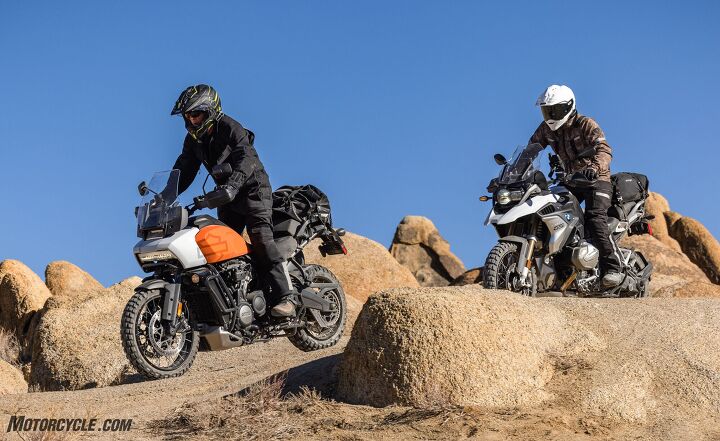
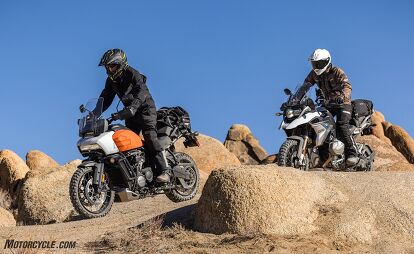



































































































































































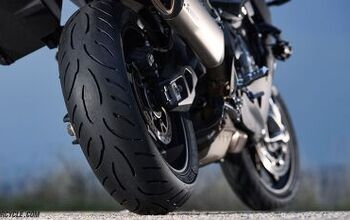

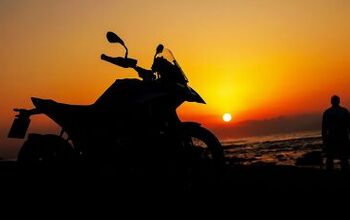


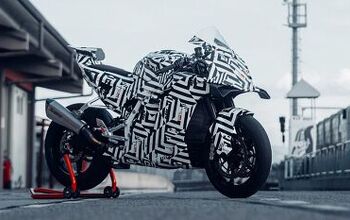










Comments
Join the conversation
Maintenance is going to be easier on the Pan Am. No valves adjustments is a BIG plus. Also, I saw the Pan Am in person and it is one ugly lump of a motorcycle. Harley should just paint that bike completely brown and get it over with.
After reading this article I decided to go out to the
local Harley-Davidson dealer and see a Pan America in person. I find one by the
front door that is clearly someone’s daily rider. Judging by the mud and bugs a
well-used machine. Nobody so much as looked up from their desk. Walked pass the big baggers looking for a new
Pan America. The sales person jumps up “How you doing can I show you anything”.
I asked if they had another Pan America. He replies “the boss’s girlfriend puts
the miles on that” then turns and walked away. This bike is not going to
succeed until Harley-Davidson does something about that mind set at the dealer
level.